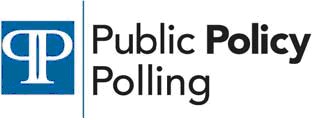Barack Obama's looking somewhat weak in our national polling. The good news for him is that his prospective Republican opponents look even weaker, and that's allowing him to maintain healthy leads in head to head match ups against each of them looking toward next year.
Voters are evenly divided on Obama with 47% who think he's doing a good job and 47% who are unhappy with his performance. His numbers break down in a predictable fashion. Democrats (82% approval) love him, Republicans (86% disapproval) hate him even more than the Democrats love him, and independents (46/47 spread) split almost right down the middle. It would be hard to characterize the attitude of the overall electorate toward Obama right now as anything other than 'mixed feelings.'
Voters don't have mixed feelings about the Republican candidates though- they pretty universally dislike them. Mike Huckabee's favorability comes out the best at a -7 spread (35/42). That's followed by Mitt Romney at -12 (32/44), Tim Pawlenty at -18 (15/33), Herman Cain at -20 (9/29), Sarah Palin at -22 (35/57), and Newt Gingrich at -31 (26/57). It's a sign of just how much of a disaster the rollout of Gingrich's candidacy was that he's now managing even worse numbers than Palin.
The result of the unpopularity of the Republican candidate field is that even if voters are closely divided on Obama, they'll still take him when they have to choose between him and any of the GOP hopefuls. Huckabee and Romney poll the best, trailing Obama by 5 points at 48/43 and 47/42 respectively. Each of them would at least make things a little bit more competitive than John McCain did- perhaps take back a North Carolina or Indiana and reduce Obama's electoral vote margin. Against any of the other Republicans at this point though Obama would build on his 2008 win. He leads Gingrich by 11 points at 50-39, Pawlenty by 14 at 47-33, Palin by 15 at 53-38, and Cain by 18 at 47-29.
It should be noted that these match ups are likely to tighten once Republicans unify around a candidate. The uncertainty about who the GOP candidate will be results in there being many more undecided Republican voters than Democrats in each of these contests. There are 4% more Republicans on the fence in the Huckabee match up, 8% more in the Romney one, 10% more in the Gingrich and Palin ones, 15% more in the Pawlenty one, and 24% more in the Cain ones. That's not a big enough disparity to allow any of them to make up the entire gap but it is big enough to move them closer.
Pawlenty and Cain were the 'bonus' Republicans on this month's poll so their numbers seem a little more worth delving into. This is the first time we've included Pawlenty on a national poll since December of 2009. His name recognition has improved from 36% to 48% in the last 15 months. The bad news for him is that his favorability has just gone from 12% to 15% while his unfavorabilty has gone from 24% to 33%. That's because his negatives with Democrats have risen at a much higher rate (from 32% to 48%) than his positives with Republicans have improved (from 16% to 23%.) So basically Democrats are developing a negative opinion of him at 2X the rate Republicans are developing a positive opinion of him.
And here's a fact that doesn't bode well for Pawlenty as he becomes better known. With voters who have no opinion about him, he trails Obama only 38-31. With voters who do feel like they know enough about him to have an opinion he trails the President 58-36. So if he becomes the GOP nominee by attrition, well, Democrats are probably fine with that. But these numbers don't really suggest that Republican voters will turn toward Pawlenty as they get to know him better either, so I'm not sure about the 'default' theory, although it's as plausible as anything else out there in this highly unsettled field.
Cain meanwhile has negative favorability numbers even with Republicans at 12/17. I'm not really surprised because our polling consistently finds that voters who aren't familiar with a politician are much more likely to rate them negatively in the absence of real knowledge than positively. You probably start out at a -10 favorability deficit. So Cain's numbers, although unimpressive no matter how you slice it, are probably more a function of that than some segment of GOP voters actively disliking him.
Full results here
Wednesday, March 16, 2011
Subscribe to:
Post Comments (Atom)




3 comments:
I suppose I can keep posting on this and no one will comment, but the age break downs that the PPP are finding make little sense.
In the 2008 exit poll, voters aged 18-29 made up 18% of the vote.
http://www.cnn.com/ELECTION/2008/results/polls.main/
In 2004 voters aged 18-29 made up 17% of the electorate.
http://www.cnn.com/ELECTION/2004/pages/results/states/US/P/00/epolls.0.html
This poll is understating the observed turnout of the young in the last 2 Presidentil Elections - which also has been the most Democratic portion of the electorate.
Why this isn't the single most important cross-tab to discuss is beyond me.
Could we please see some regional crosstabs? Especially in the light of Brown (D-OH)'s numbers skyrocketing, it would be nice to know if this supposed spike in Midwest Dem popularity is supported in Presidential polling attitudes.
We'll have OH presidential numbers out tomorrow, and we put out WI a week or two ago. We didn't ask a region question on this national poll, though, so we couldn't break it down.
Post a Comment